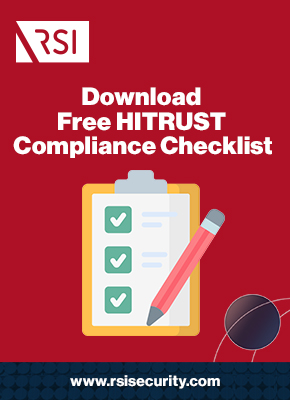The HITRUST CSF can help organizations streamline compliance across multiple regulatory frameworks, address security gaps, and strengthen overall cybersecurity. Compliance with the HITRUST CSF may require your organization to complete a HITRUST Validated Assessment to verify adherence to HITRUST CSF controls. Read on to learn more.
Components of a HITRUST Validated Assessment
Preparedness is critical to a successful HITRUST Validated Assessment. To best prepare for the HITRUST CSF assessment, it helps to build familiarity around:
- Criteria for Validated Assessments
- Types of Validated Assessments
- Role of HITRUST CSF External Assessors
With the help of an experienced HITRUST CSF assessor, your organization can best prepare for a HITRUST Validated Assessment.
Download Our HITRUST Compliance Checklist
Does Your Organization Need a HITRUST Validated Assessment?
Completing a HITRUST CSF assessment helps entities achieve broad cybersecurity protections, regardless of industry. A HITRUST Validated Assessment can also help your organization meet specific goals, some of which include:
- Assess the current state of organization-wide cybersecurity
- Identify existing and unknown gaps in security for immediate remediation
- Evaluate regulatory compliance internally and externally (third-party providers)
- Demonstrate independently-assessed security and compliance to potential business associates
Before completing a HITRUST Validated Assessment, organizations must complete a self-assessment to evaluate compliance with relevant HITRUST CSF control requirements.
Request a Free Consultation
HITRUST CSF Self-Assessment
A HITRUST CSF self-assessment evaluates HITRUST CSF compliance based on HITRUST CSF Assurance Program criteria. Specifically, organizations complete questionnaires to assess compliance with HITRUST CSF controls and requirements.
A self-assessment will evaluate compliance for the PRISMA-based Maturity Levels, including:
- Established policies or standards
- Processes to support established policies
- Implementation of processes
- Testing of operational efficiency of processes
- Management of testing results to initiate corrective actions when required
Organizations can indicate compliance for each Maturity Level via options that include:
- “Non-compliant”
- “Somewhat compliant”
- “Partially compliant”
- “Mostly compliant”
- “Fully compliant”
HITRUST self-assessment can help identify security and compliance gaps that must be addressed before completing a HITRUST Validated Assessment.
MyCSF Tool for Self-Assessment
The HITRUST MyCSF tool can help your organization complete a self-assessment and adequately prepare for the HITRUST Validated Assessment.
Specifically, MyCSF can help:
- Accurately score compliance based on HITRUST controls and Maturity Levels
- Perform custom assessments for your organization-specific needs
- Report and track compliance by:
- Compiling evidence and supporting documentation
- Preparing standardized compliance reports
- Manage Corrective Action Plans (CAPs) for both HITRUST CSF and non-HITRUST assessments
The MyCSF tool helps simplify preparation for the HITRUST Validated Assessment.

Types of HITRUST Validated Assessments
Following self-assessment, entities can complete a HITRUST Validated Assessment with the help of a qualified HITRUST CSF external assessor.
Until recently, the go-to validated assessment was the HITRUST CSF Validated Assessment, which provides a more rigorous evaluation of security risks with the highest assurance. The HITRUST CSF Validated Assessment is now called the HITRUST r2 Validated Assessment and still addresses HITRUST CSF compliance for organizations that prefer more rigorous security assessment.
However, if your organization has a moderate security risk profile, the recently added HITRUST i1 Validated Assessment can meet your security needs. Working with a leading HITRUST CSF Assessor will help you determine which HITRUST Validated Assessment best suits your organization’s needs.
HITRUST i1 Validated Assessment
Although the HITRUST i1 Validated Assessment requires moderate effort, it is considered a threat-adaptive assessment. Specific features of the HITRUST i1 Validated Assessment include:
- Covers approximately 219 HITRUST CSF requirements
- Scores compliance based on one Maturity Level (i.e., Implemented)
- Certification lasts one year
- Caters to compliance frameworks, including:
- NIST 800-171
- GDPR (specifically the Safeguards Rule)
- AICPA TSC
While the HITRUST i1 Validated Assessment cannot be tailored to organization-specific controls, it will help you achieve good security hygiene and help manage moderate security risks for your cyber assets.

HITRUST r2 Validated Assessment
Unlike the i1 Validated Assessment, the r2 HITRUST Validated Assessment requires a high level of effort and offers the highest security assurance.
Comprehensive and risk-based, the r2 Validated Assessment contains several features, some of which include:
- Covers a range of 198 to 2000 or more HITRUST CSF requirements, with:
- An average of 360 requirements within the scope of assessments
- Requirements based on risk factors inherent to entities
- Scores compliance based on all five Maturity Levels
- Achieves compliance across over 37 frameworks, some of which include:
- Certification lasts two years
The HITRUST r2 Validated Assessment provides the highest level of cybersecurity assurance for your organization. Working with a HITRUST CSF Assessor will help you identify the most appropriate HITRUST Validated Assessment for your risk profile.
How Can a HITRUST CSF External Assessor Help You?
A qualified HITRUST CSF External Assessor can help you complete a HITRUST CSF Validated Assessment. Your HITRUST CSF External Assessor will assess compliance by:
- Conducting walkthroughs and personnel interviews
- Observing processes related to specific HITRUST CSF controls
- Testing technical aspects of relevant controls
- Evaluate evidence collected for compliance reporting
It is critical to work with a qualified HITRUST CSF External Assessor who conducts assessments based on HITRUST Assurance Program and HITRUST CSF requirements, increasing your preparedness to:
- Obtain HITRUST CSF certification
- Remediate any outstanding security gaps
- Strengthen overall cybersecurity
With the help of an experienced HITRUST CSF External Assessor, you will complete a HITRUST Validated Assessment that best protects your entity from evolving cyber threat risks.
Achieve Better Preparedness for HITRUST Validated Assessments
Organizations that complete HITRUST Validated Assessments are better prepared for HITRUST certification. With the help of a qualified HITRUST CSF External Assessor, you will streamline compliance across several frameworks and strengthen overall cybersecurity.
Contact RSI Security today to learn more about rethinking your HITRUST CSF compliance.

